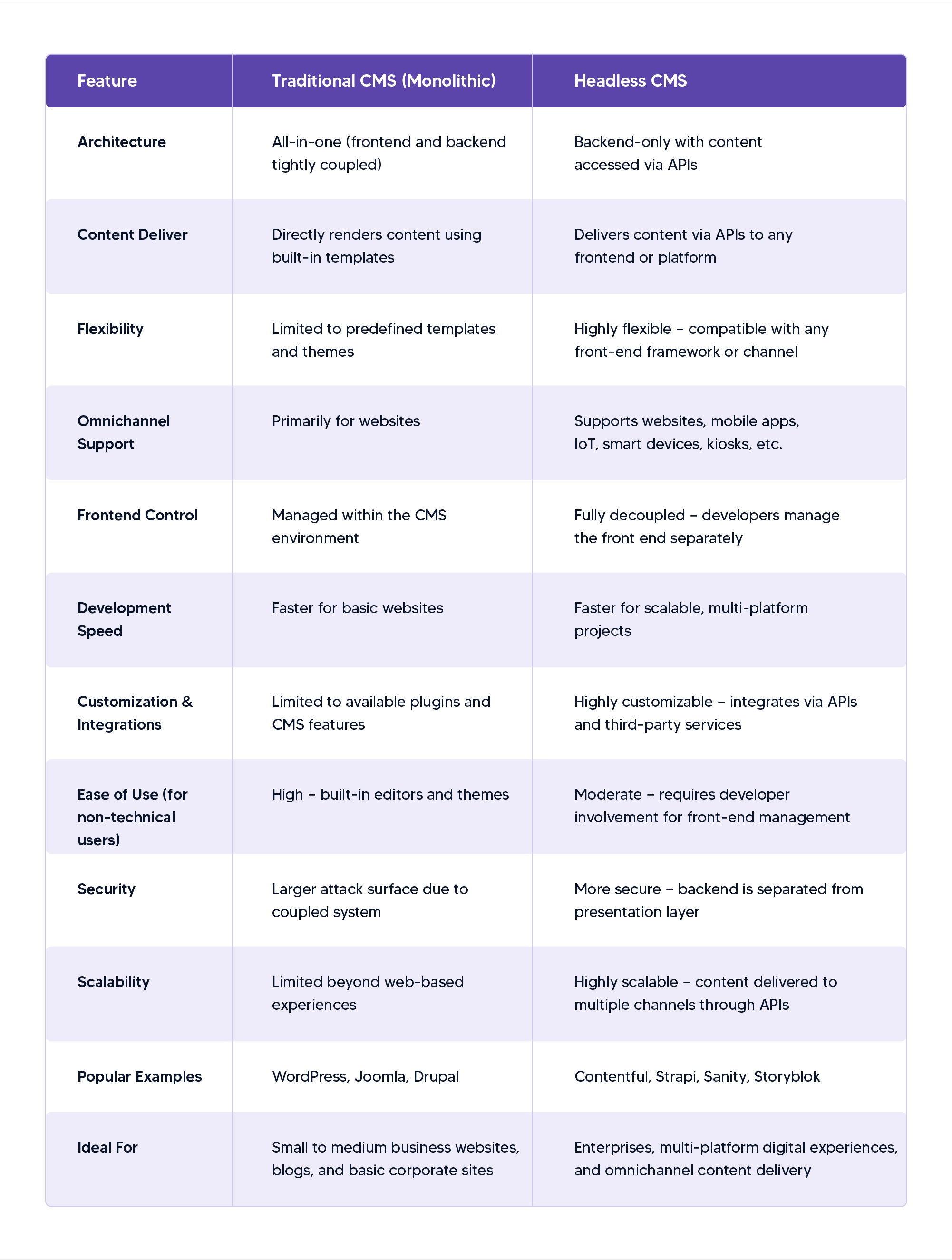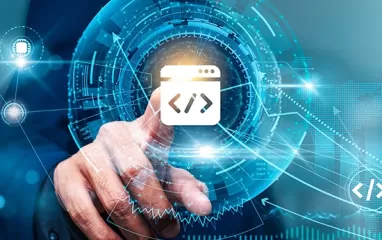Other recent blogs



Let's talk
Reach out, we'd love to hear from you!
Picture this: Your team wants to push an urgent product update across your website, mobile app, and that new IoT dashboard you launched last quarter. What should take minutes turns into a week-long ordeal involving three different systems, two developer tickets, and one very frustrated product manager.
While your competitors are iterating and launching at breakneck speed, your team is stuck playing referee between content creators and inflexible systems that were designed when 'mobile-first' wasn't even a buzzword. Is it a technology problem or a business velocity challenge?
Well, here’s the brutal reality - traditional CMS platforms served us well when business meant one website and one audience. But your customers now expect seamless experiences whether they're browsing on their phone during lunch, checking your app before a meeting, or interacting with your brand through voice assistants. The headless CMS approach isn't just about keeping up—it's about building the content infrastructure that lets you move faster than the market.
If you’re wondering if there are benefits to being headless, then honestly, traditional CMSs weren't built for today's multi-channel world, and here's what headless CMS really means for your business. So, let’s dive into why Headless CMS can be a strategic move to keep your business ahead of the curve in this blog.
What’s a Headless CMS?
At its core, a Headless CMS is like a super-organized librarian who hands you exactly the book you need without telling you how to read it. Unlike traditional CMS platforms—like WordPress or Drupal—where content creation and display are glued together, a Headless CMS splits them apart. The “head” (the frontend, or how content looks) is chopped off, leaving a lean backend that stores and manages content. That content—text, images, videos, you name it—gets delivered through APIs to whatever platform you want: websites, apps, and even VR headsets.
Here’s the breakdown:
- Content hub: Think of this as your central vault. Marketers and editors create and organize content here—blog posts, product specs, whatever. It’s stored in a clean, structured format (like JSON), not tied to any specific design or layout.
- API magic: In a headless CMS, the API-first approach delivers content via RESTful or GraphQL APIs. RESTful APIs use HTTP methods to fetch content as resources, ideal for simple integrations, but may need multiple requests. GraphQL APIs allow precise data queries in one request, reducing overfetching for dynamic apps. Both enable developers to build custom experiences across platforms, ensuring flexibility, scalability, and future-proof content delivery without CMS restrictions.
- Frontend freedom: Your development team acts as creators, sculpting interfaces with preferred tools—React, Flutter, or emerging tech—unshackled by CMS oversight. They define the aesthetic and functionality across platforms, with the CMS serving solely as a content provider, not a controller.
Why does this matter? Because today’s digital world isn’t just websites anymore. Your customers are scrolling apps, talking to voice assistants, or browsing smart TVs. A Headless CMS lets you create content once and beam it everywhere with no sweat.
Traditional CMS limitations vs Headless CMS benefits: A strategic comparison
Traditional CMS platforms are like all-in-one printers: they edit, design, and publish, but good luck getting them to do anything fancy. They bundle content management with templates and themes, which sounds convenient until you try pushing content to a mobile app or a digital billboard. Suddenly, you’re hacking together plugins or rebuilding from scratch. Scaling for new platforms? That’s a headache of workarounds and custom code.
Headless CMS flips the script by decoupling content from the presentation. It gives you a single source of truth—your content lives in one place and flows to any platform via APIs. Platforms like Contentful, Strapi, or Sanity let your developers craft pixel-perfect frontends with modern frameworks, no strings attached. Need to update a product description?
Change it once, and it syncs across your website, app, and smartwatch in real time. It’s like upgrading from a flip phone to a smartphone—suddenly, everything’s possible.
Here’s a detailed comparison table

Why Headless CMS is better for business? Revealing Headless CMS benefits

Alright, let’s get to the good stuff: why should you, as a CEO or CTO, care? Here’s what a Headless CMS brings to the table.
Flexibility that keeps up with your vision
Traditional CMS platforms are like buying a suit off the rack—it fits, but it’s not you. Their templates and plugins box you in, forcing your team to compromise on design or functionality. A Headless CMS hands you a blank canvas. Your developers can build exactly the experience you want, using the latest tech—say, a sleek React frontend or a Flutter app—without the CMS saying, “Nope, not allowed.” Want to launch a new feature on wearable devices? No problem. Your content’s ready to roll, no rebuild required. This flexibility means your digital presence stays as bold and unique as your brand.
Speed that wins the race
In today’s market, slow is a death sentence. A Headless CMS turbocharges your workflow. Content teams and developers work side by side—marketers polish copy while coders tweak the frontend, no waiting around. APIs make integrations a breeze, so hooking up your CRM, analytics, or e-commerce platform feels like snapping together Legos. The result? Faster launches and campaigns that hit the ground running. One company I heard about slashed their app update time from weeks to days after going headless. That’s the kind of edge that keeps customers coming back.
Omnichannel like you mean it
Your customers don’t just browse—they’re everywhere. Websites, apps, voice assistants, even AR displays at your retail store. A traditional CMS struggles to keep up, spitting out content that’s stuck in “website mode.” A Headless CMS is built for this chaos. Create a blog post or product update once, and it flows seamlessly to every channel. Your messaging stays consistent, whether someone’s checking their phone or asking Alexa for your latest deal. Plus, managing it all from one dashboard saves your team from juggling multiple systems. It’s omnichannel done right.
Scalability that doesn’t flinch
Growth is great—until your CMS buckles under the pressure. Most Headless CMS platforms are cloud-native, meaning they’re built to handle spikes in traffic or global expansion without blinking. Content Delivery Networks (CDNs) ensure your site or app loads lightning-fast, no matter where your audience is. And forget about babysitting updates—providers handle security patches and maintenance, freeing your IT team for bigger wins. Whether you’re launching in new markets or handling a viral campaign, a Headless CMS scales with you.
Future-proof technology
As traditional CMS platforms risk obsolescence, a headless CMS, with its API-driven architecture, decouples content from presentation, enabling seamless integration with emerging frameworks like Svelte or Next.js. It supports innovative interfaces, including AR/VR, voice search, and IoT, while facilitating AI-driven personalization for real-time user engagement. This agnostic design allows developers to adopt new technologies without backend overhauls, ensuring scalability and flexibility. By prioritizing modularity, a headless CMS empowers organizations to meet current demands and swiftly adapt to future trends, maintaining a competitive edge in evolving digital ecosystems.
Okay, what’s the catch?
No solution’s perfect, and Headless CMS isn’t a magic wand. Here’s what to watch out for - Unlike traditional CMS platforms with drag-and-drop editors, headless requires developers to build the frontend from scratch. If your team is lean or lacking in coding skills, you’ll need to budget for external help or training.
Additionally, freedom comes with a price tag. Custom frontends and API-driven setups can mean higher initial costs compared to an off-the-shelf CMS. But think long-term—fewer plugins and faster workflows often save money down the line.
Also, your marketers might miss the “what you see is what you get” vibe of traditional CMS. A Headless CMS focuses on raw content, not previews, so there’s a learning curve. Good onboarding can smooth this out. These aren’t dealbreakers, but they’re worth weighing. If your business thrives on custom experiences and has the tech muscle to back it up, the trade-offs are usually worth it.
Is Headless CMS really the future?
Here’s the million-dollar question: Is this the endgame for content management? Honestly, it’s not about headless being the only way—it’s about what it represents. The digital world’s exploding with new platforms, from voice assistants to immersive AR. Customers expect seamless, personalized experiences, and businesses need systems that deliver without drama. Headless CMS nails this by putting content first and letting you build around it.
But the future’s bigger than just “headless.” We’re already seeing AI sneak into the mix—think content that auto-tags itself or personalizes based on user habits. Composable architectures, where you mix and match tools like a tech buffet, are gaining steam. A Headless CMS fits perfectly into this puzzle, acting as the content engine while other systems handle analytics, commerce, or AI magic. It’s less about replacing everything and more about building a stack that evolves with you.
So, should you go Headless? If you’re a CEO or CTO staring down a digital roadmap, here’s the deal: A Headless CMS is a powerhouse for businesses that need flexibility, speed, and a presence across multiple platforms. It’s ideal if you’ve got developers ready to roll and a vision that doesn’t fit cookie-cutter molds. Enterprises like Spotify or Nike are already leaning into headless for their global reach—proof it can handle the big leagues.
But if your team’s small, your budget’s tight, or you’re happy with a simple website, a traditional CMS might still do the trick. The key is matching your choice to your goals. Ask yourself: Are we building for scale? Do we need custom experiences? Can we handle the tech lift? If you’re nodding “yes,” headless could be your next move.
What are the key challenges of Headless CMS implementation?
Although headless CMS provides flexibility and scalability, this is not a one-size-fits fit approach. There are a number of issues which may make its adoption difficult, especially for specific teams or use cases. It is important to know these hoops in order to get a feel of whether headless CMS is what your organization requires.

Steeper learning curve:
In contrast to what the traditional CMS platforms have to offer with its intuitive WYSIWYG editors, and previews built-in, headless CMS does not offer a visual interface. Non-technical users can be the wrong implication such as marketers or content editors could have difficulty working on content without regards on how it will appear on the front end. The reliance on developer interventions for getting content previews or updates can slow workflows and lead to bottlenecks, necessitating further training or bespoke solutions to create a bridge.
Higher initial and maintenance costs:
It is common that implementing a headless CMS requires greater expenses at the beginning. Organizations need to spend on custom frontend development, API integration, and infrastructure for omnichannel delivery. Continued maintenance from hosting to API management and updating frontend frameworks may continue to drive up the costs. These costs could overshadow the advantages of flexibility, especially compared to the all-in-one traditional CMS solutions for smaller teams or budgets.
Vendor lock-in risks:
Although headless CMS embraces operational freedom, some companies lock in users on proprietary APIs, hosting, or even data structures. The process of changing vendors may be complex when content has been integrally bound to a particular ecosystem of a platform. Organizations need to thoroughly review vendors’ agreements to allow content portability and avoid prolonged reliance on vendors, which might hinder further growth or end up being costly when switching to a new vendor.
API limitations:
The API-first approach, as powerful as it may be, implies limitations. Rate limits, payload limits, or query complexity (in a specific case – GraphQL) may worsen the performance of an application, especially one with high traffic. Overfetching or underfetching the data might be subject to further optimization, taking more time to develop. In addition, API designs that are not well thought out or inconsistent documentation can anger developers which will have an impact on inefficiency in content delivery accross platforms.
Security and compliance risks:
A headless CMS exposes content via APIs, which can introduce vulnerabilities if not properly secured. Misconfigured APIs, inadequate authentication, or unpatched endpoints may invite attacks. Compliance with regulations like GDPR or CCPA can also be complex, as content is distributed across multiple platforms, requiring robust data governance. Organizations must invest in security measures, such as encryption and access controls, to mitigate risks.
These challenges highlight the need for careful planning. A headless CMS thrives in developer-driven, omnichannel environments but may overwhelm teams lacking technical resources or requiring simple, visual content management.
Wrapping up:
A headless CMS transcends mere technology—it’s a strategic shift toward agile content management, freeing organizations from rigid, monolithic systems. It empowers developers to innovate, scale, and deliver seamless content across multi-device ecosystems. Despite challenges, the benefits like rapid deployments, developer autonomy, and flexible content delivery—are transformative.
Kellton, as a premier headless CMS partner, mitigates these obstacles with tailored solutions. They provide intuitive interfaces for non-technical users, optimize costs via cloud architectures, ensure vendor flexibility with open standards, enhance API performance for scalability, and fortify security to meet GDPR and CCPA compliance.
With over 1,800 experts and a proven track record in digital transformation, Kellton enables businesses to launch faster, empower teams, and adapt to trends like AI personalization or AR/VR. Ready to embrace the agility of headless CMS with Kellton’s expertise or stay with traditional systems? The future demands flexibility—Kellton paves the way.



